Technology evolves, and in the blockchain world, we often hear about Web3. But what is all the craze about and how is Web3 different from Web2? We will need to dive deep and rewind to Web 1 to make sense of Web3.
Let’s start with the fundamentals of the Web, and the differences between Web2 and Web3.
Web1 (1990-2005)
In a nutshell, Web 1.0 was the first phase of the web (1990-2005). During this stage, Web1 was read-only, which allowed users to view static data on websites without having the chance to express their thoughts or remarks.
At the time, users were charged based on the number of pages they visited. For instance, MySpace, Google, LiveJournal, and Yahoo apparently charged users for using their pages.
Web2 (2006-present)
Moving onto Web2, the internet that is currently in use worldwide. Instead of static, boring content, the web became a place for dynamic content, where users can fully interact with the content published on the web.
Upon discovery, JavaScript, HTML, and CSS allowed developers to build apps where users can interact with content in real-time.
Additionally, Web2 is completely interaction-based. It allows users to create content and distribute it on global networks. For instance, Instagram, Facebook, Youtube, and Twitter.
Web3 (The Future)
Web3 is the most trending topic of today, and it is also known as the Semantic Web. Following Web2, the third generation depends on complicated software and artificial intelligence (AI) to run the web. Web3 aspires to provide a trustworthy and data-driven UI that caters to every user. Blockchain, metaverse, and Semantic Web are expected to be leveraged through Web3.
The main purpose of Web3 is to enable users to find, share and combine information more easily.
Nevertheless, blockchain enthusiasts have taken Web3 into a new realm and mean a lot more than just the Semantic Web. Metaverse, cryptocurrencies, and NFTs, all form a part of Web3.
What Are the Differences Between Web2 and Web3?
Web2 and Web3 share similar technologies, but they approach challenges differently. While Web2 aims to connect people, Web3 combines this data in meaning along with increasing trust because of decentralization.
Below are some of the differences:
Security
Web2 is centralized, which means application delivery, cloud services, and platform are governed and operated by centralized authorities. Whereas Web3 is decentralized, wherein edge computing, peer-to-peer, and distributed consensus increasingly become the norm in Web3.
Currency
Web2 payments and transactions occur with government-issued currency, such as the US dollar. Web3, on the other hand, uses cryptocurrencies, such as Ethereum or Bitcoin.
Speed
Web2 transfers are faster than Web3. Web2 scans for information stored in a place. In contrast, Web3 assigns ownership to numerous others (decentralization).
Technology
Web2 uses AJAX, JavaScript, HTML5, and CSS3. Web3 uses AI, deep learning, and decentralized technologies.
How Can Users Benefit From Web3?
Web3’s biggest advantage is the decentralized structure. Here are some other uses:
More Privacy
Web3 offers more security. Users have complete control of their data, and they have the option of making their information public or private.
Security
Since Web3 uses different blockchain technology and is an autonomous structure, it is safer than the prior Web version.
Connectivity
Data is intimately associated with Web3 due to semantic content, leading to an improved user experience that goes to a new level of connectivity that harnesses all accessible data.
Decentralization will also lead to the emergence of decentralized apps that make use of blockchain and smart contracts to enable distributed applications across the Web3 landscape.
Play-to-Earn Gaming
Web3 has changed the way that games are being played with a new innovative form of network model for data sharing. Blockchain opens up the beginning of Web3 trends.
Play-to-earn (P2E) is just like normal gaming, except with the idea of earning and making a real income while playing the game. It may sound too good to be true, but it is real, with games like Axie Infinity being one of the most trending P2E games currently.
Non-fungible tokens (NFT)
The art industry is already experimenting with Web3 technology to open up new ways for artists and interested buyers. For instance, OpenSea, the largest and most popular NFT marketplace, is a platform that allows users to mint their artwork as NFTs. These NFTs can be bought, sold, or traded.
Conclusion
As Web3 continues to evolve and be defined, its focus on decentralization, automation, and intelligence will likely continue to be the foundation for what’s next.
Web3 could be anything from NFTs to play-to-earn games. It is the next phase of the internet. In short, Web3 will hold our financial institutions, social interactions, personal identities, and more shortly.
Learn More About Crypto, Blockchain, & Web3:
- What Is Ethereum: Complete Guide to the 2nd Largest Blockchain Project
- Explaining Ethereum Name Service (ENS): What Is It and How Does It Work?
- Ethereum vs Bitcoin: Use Cases, Technical Differences, Scaling Issues
- What Is DeFi? Let’s Understand Decentralized Finance
Disclaimer: The information presented in this article is for informational and educational purposes only. The article does not constitute financial advice or advice of any kind. Coin Edition is not responsible for any losses incurred as a result of the utilization of content, products, or services mentioned. Readers are advised to exercise caution before taking any action related to the company.









